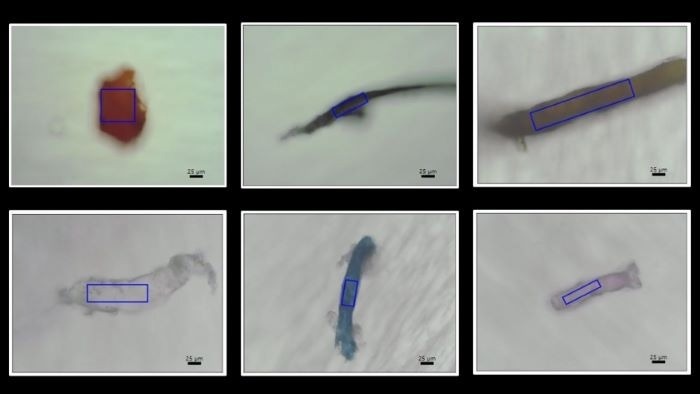Reviewed by Lexie CornerSep 23 2024
Researchers at Kyushu University have discovered that microplastics are present in various anatomical parts of coral, including the skeleton, tissue, and surface mucus. This discovery was made possible by a new microplastic detection method developed and applied by the team for the first time on coral samples. The findings were published in the journal Science of the Total Environment.
 Samples of microplastics found in coral. A variety of microplastics are extracted from corals off the coast of Si Chang Island in the Gulf of Thailand. As seen by the color, shape, and size, coral will consume a wide range of microplastics, with many of them thinner than a strand of human hair. Image Credit: Kyushu University/Isobe lab
Samples of microplastics found in coral. A variety of microplastics are extracted from corals off the coast of Si Chang Island in the Gulf of Thailand. As seen by the color, shape, and size, coral will consume a wide range of microplastics, with many of them thinner than a strand of human hair. Image Credit: Kyushu University/Isobe lab
These findings may provide insights into the "missing plastic problem," a mystery that has led scientists to estimate that 70 % of plastic debris in the oceans is hidden. The research team suggests that coral may act as a "sink" for microplastics, potentially absorbing them from the ocean.
While plastics have greatly improved convenience in daily life, humanity's dependence on them has severely impacted ecosystems, with an estimated 4.8 to 12.7 million tons of plastic entering the marine environment annually.
In Southeast Asia, plastic pollution has become a significant issue. Collectively, nearly 10 million tons of plastic waste are dumped annually, equivalent to 1/3 of the world’s total. Some of this plastic is discharged into the ocean, where it degrades into microplastics.
Suppakarn Jandang, Assistant Professor and Study First Author, Research Institute for Applied Mechanics (RIAM), Kyushu University
In 2022, RIAM and Chulalongkorn University in Thailand established the Center for Ocean Plastic Studies to address plastic pollution in Southeast Asia. Professor Atsuhiko Isobe, leading the international institute, oversaw the research team that produced these recent findings.
The team conducted fieldwork on the coast of Si Chang Island in the Gulf of Thailand, focusing on the impact of microplastics on local coral reefs. This region is known for its small reef flats and serves as a prominent location for anthropological research.
Coral has three main anatomical parts: the surface mucus, the outside of the coral body; the tissue, which is the inner parts of the coral; and the skeleton, the hard deposits of calcium carbonate they produce. Our first step was to develop a way to extract and identify microplastics from our coral samples. We put our samples through a series of simple chemical washes designed to break apart each anatomical layer. After each subsequent layer was dissolved, we would filter out the content and then work on the next layer.
Suppakarn Jandang, Assistant Professor and Study First Author, Research Institute for Applied Mechanics (RIAM), Kyushu University
The researchers collected and analyzed 27 coral samples from four different species, finding a total of 174 microplastic particles, mostly in the 101–200 μm size range—comparable to the width of a human hair. Of the detected microplastics, 38 % were found in the surface mucus, 25 % in the tissue, and 37 % in the skeleton.
The most common types of microplastics identified were nylon (20.11 %), polyacetylene (14.37 %), and polyethylene terephthalate (PET) (9.77 %).
These findings suggest that coral may act as a marine plastic "sink," absorbing microplastics from the ocean, similar to how trees sequester carbon dioxide.
“The ‘missing plastic problem’ has been troubling scientists who track marine plastic waste, but this evidence suggests that corals could account for that missing plastic. Since coral skeletons remain intact after they die, these deposited microplastics can potentially be preserved for hundreds of years. Similar to mosquitos in amber,” said Jandang.
However, further research is needed to fully understand the impact of these findings on coral reefs and the global ecosystem.
The corals that we studied this time are distributed all around the world. To get a more accurate picture of the situation, we must conduct extensive studies globally across an array of coral species. We also do not know the health effects of microplastics on coral and the larger reef community. There is still much to be done to accurately evaluate the impact of microplastics on our ecosystem.
Atsuhiko Isobe, Professor, Research Institute for Applied Mechanics, Kyushu University
Journal Reference:
Jandang, S., et al. (2024) Possible sink of missing ocean plastic: Accumulation patterns in reef-building corals in the Gulf of Thailand. Science of the Total Environment. doi.org/10.1016/j.scitotenv.2024.176210